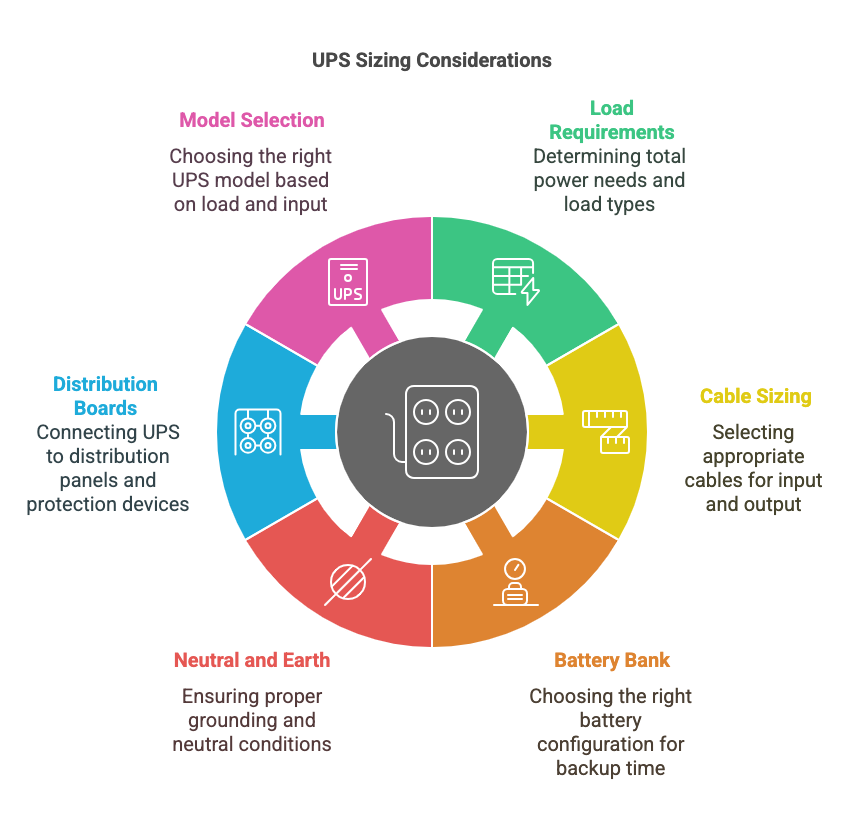
In commercial and industrial environments, uninterrupted power is critical to ensuring smooth operations and preventing costly downtime. OE Online UPS systems, ranging from 5 kVA to 20 kVA, are designed to deliver reliable backup power and power conditioning.
This guide focuses on how to size an OE Online UPS correctly, taking into account customer load profiles, UPS constraints, cable sizing, and power quality considerations.
1. Understanding the OE Online UPS Specifications
OE Online UPS Systems are available in the following configurations:
- 5/6 kVA: 192 VDC battery bank
- 10 kVA (1:1): Single-phase input, single-phase output, 192 VDC
- 10 kVA (3:1): Three-phase input, single-phase output, 240 VDC
Key Output Specs:
- Output Voltage: 230V ±1%
- Output Frequency: 50 Hz ±0.5 Hz
- Load Power Factor: 0.7
- Crest Factor: 3:1
- Efficiency: 86%
- Overload Handling: 110% for 10 seconds
Input Specs:
- Input Frequency: 45.5 – 54 Hz
- Input PF: >0.8
- Input THDi: <5%
2. Determining the Load Requirements
Step 1: List All Critical Loads Prepare a load sheet that identifies the following:
- Nameplate Power Ratings (kW or kVA)
- Type of Load (Linear, Nonlinear)
- Duty Cycle
- Startup Characteristics (inrush)
The key parameters to extract:
- Total load in Watts (W) or Volt-Amperes (VA)
- Load type: linear (resistive) or non-linear (IT equipment, etc.)
- Load power factor (PF)
Step 2: Calculate Total Load in kVA
For mixed loads:
VA = Watts ÷ Power Factor
Example: If total real power = 5,000 W and average load power factor = 0.7
This would require a 10 kVA UPS minimum.
Step 3: Check UPS Output Capacity and Model
From OE’s specifications:
- Available models: 5 kVA to 20 kVA
- Load PF = 0.7 (this is what the UPS is designed for)
- Output voltage: 230 V ±1%
- Crest factor: 3:1 (important for peak load handling)
So, the 10 kVA OE Online UPS is the suitable model.
Step 4: Consider Load Type
- Linear Loads: Resistive heating, incandescent lamps
- Nonlinear Loads: Computers, VFDs, LEDs
- Inductive/Capacitive Loads: Motors, transformers (may need derating)
- Harmonic Loads: UPS must handle higher crest factors
OE UPS handles:
- <3% distortion with linear loads
- <5% distortion with nonlinear loads
- Crest factor 3:1 ensures tolerance to peak currents
3. Input and Output Cable Sizing
Proper cable sizing ensures safety, efficiency, and compliance with electrical standards. Here’s how to calculate input and output cable sizes for the 10 kVA OE Online UPS.
a: Input Power Calculations
Efficiency = 86%, so the power drawn from the mains will be:
Input Power (W) = Output Power(W) ÷ Efficiency = 7000 ÷ .86 ≈ 8139.5
Input power in VA:
Using input PF = 0.8 (minimum specified),
VA = 8139.5 ÷ .8 ≈ 10,174
So, the input mains wiring and circuit breakers must support at least 10.2 kVA / 8139 W, factoring in surge if needed.
b. Input Cable Sizing
For a 10 kVA unit:
- Input Current = for 3-phase = ((10,000 ÷ 0.8) ÷ 1.732) ÷ 230 ≈ 31 A
- Choose cable rated for 125% of current: 4C x 6 sq.mm Cu or higher
c. Output Cable Sizing
- Output Current (Single Phase) ≈ ~43.5 A
- Use 2C x 10 sq.mm Cu for safe operation
Factor in derating for temperature, laying conditions, and run length.
4. Battery Bank Consideration
OE UPS models use 192VDC or 240VDC battery banks:
- 192VDC = 16 batteries (12V each)
- 240VDC = 20 batteries
- Battery AH rating based on backup time:
- 30 min backup @ 10 kVA requires ~100-120 AH
- 60 min backup may require 150-180 AH
Always consider:
- Battery discharge rate
- Temperature compensation
- Rack space and ventilation
5. Neutral and Earth Conditions
Neutral and earth conditions directly impact the reliability of UPS systems:
a. Neutral Sizing & Harmonics
- Nonlinear loads generate 3rd harmonics that add up in the neutral
- Always oversize the neutral or use K-rated isolation transformers
b. Earthing Practices
- UPS chassis and battery bank must be earthed
- Use a clean signal ground for sensitive equipment
- Avoid earth loops
c. Neutral-Earth Voltage
- Keep NE voltage < 2V
- High NE voltage can lead to improper bypass or noisy output
6. LT Panels, Distribution Boards, and Controls
UPS output connects to:
- LT Panel / Main Distribution Board (MDB)
- Sub-distribution Boards (SDBs)
- Each board may feed:
- Sockets
- Switches
- Lighting circuits
- Equipment outlets
Protection Devices:
- MCBs: Short circuit and overload protection
- Isolators: Manual disconnection
- RCCBs/RCBOs: Earth leakage protection
Ensure devices are rated for UPS output waveform and frequency stability.
7. Selecting the Right OE UPS Model
| Load Profile | Recommended Model | Input Type | Battery VDC |
|---|---|---|---|
| Small Office / Server Room (5-6 kVA) | OE 5/6 kVA | Single-Phase | 192V |
| IT Room / Telecom / Lab (10 kVA) | OE 10 kVA (1:1) | Single-Phase | 192V |
| Industrial Loads / Data Center Edge (10 kVA) | OE 10 kVA (3:1) | 3-Phase | 240V |
Choose model based on:
- Input availability (single vs three-phase)
- Load sensitivity
- Backup time required
Conclusion
Sizing a UPS is more than just adding up wattages. It requires a clear understanding of load characteristics, harmonics, power factor, battery autonomy, neutral-earth relationships, and cable capacity. OE Online UPS systems offer high performance, clean output, and reliable operation—but to get the best results, they must be sized and installed with precision.
If you would like a free UPS sizing assessment for your site, contact us at info@ohmelectricals.in or fill out the site load sheet form on our website.
